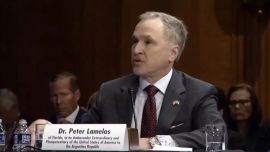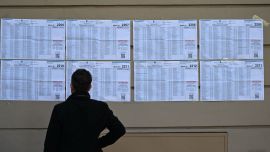Argentina's poverty rate reached 54.9% and destitution 20.3% nationwide during the first quarter of 2024, according to the influential observatory headed by Universidad Católica Argentina.
The recession is taking its toll on Argentina and the ODSA (Argentine Social Debt Observatory), part of the Universidad Católica Argentina (UCA) highlighted that the poverty rate reached 54.9 percent and destitution 20.3 percent in the first quarter of 2024.
Official sources quoted by portal Infobae use the database of the EPH Permanent Household Survey published by INDEC. Within its latest report, the OSDA had already asserted that poverty was 55.5 percent and destitution 18.5 percent of the country.
Now that the official data have been revealed, the body led by Marco Lavagna renewed its destitution figure, which amounted to 20.3 percent. These data were above the fourth quarter of 2023, when the poor were 45.2 percent of the population and destitution 14.6 percent.
In addition, the data are even more relevant when compared with those of the first half of 2023, when poor households accounted for 29.6 percent (40.1 percent of people) and destitution stood at 6.8 percent (9.3 percent of people). This shows a 14.8-percent increase in terms of poor people and 11 percent for destitution over nine months, seven of them during Javier Milei’s government.
Breaking down the data, the poorest urban conurbation of the country is Greater Resistencia, Chaco, where the rate climbs up to 79.5 percent in poverty and destitution to 38.6 percent. Conversely, Buenos Aires City has the lowest poverty level in the country at 25.5 percent and destitution at 8.5 percent.
Poverty levels by urban conurbation in first quarter of 2024
♦ Greater Resistencia: 79.5 percent.
♦ Formosa: 72.1 percent.
♦ La Rioja: 68 percent.
♦ Santiago del Estero/La Banda: 67.1 percent.
♦ Concordia: 67 percent.
♦ Greater Buenos Aires Districts: 61.9 percent.
♦ Greater Santa Fe: 60.6 percent.
♦ Greater Tucumán/Tafí Viejo: 60.2 percent.
♦ Greater San Juan: 58 percent.
♦ Greater Catamarca: 57.3 percent.
♦ Viedma/Carmen de Patagones: 57.1 percent.
♦ Salta: 56.8 percent.
♦ Rawson/Trelew: 56.5 percent.
♦ Corrientes: 55.7 percent.
♦ Posadas: 55.7 percent.
♦ Jujuy/Palpalá: 54.1 percent.
♦ Río Gallegos: 53.8 percent.
♦ Río Cuarto: 53.5 percent.
♦ Greater Mendoza: 52.5 percent.
♦ Greater La Plata: 52.4 percent.
♦ Mar del Plata/Batán: 52.2 percent.
♦ San Nicolás/Villa Constitución: 52.2 percent.
♦ Greater Córdoba: 50.7 percent.
♦ Comodoro Rivadavia/Rada Tilly: 50.5 percent.
♦ Greater Paraná: 50.5 percent.
♦ Greater Rosario: 49.1 percent.
♦ San Luis/El Chorrillo: 48.3 percent.
♦ Ushuaia/Rio Grande: 47.6 percent.
♦ Bahía Blanca/Cerri: 45.8 percent.
♦ Neuquén/Plottier: 36.6 percent.
♦ Santa Rosa/Toay: 36.2 percent.
♦ Buenos Aires City: 25.4 percent.
Total for country: 54.9 percent
Destitution levels by urban conurbation in the first quarter of 2024
♦ Greater Resistencia: 38.6 percent.
♦ Santiago del Estero/La Banda: 29.9 percent.
♦ Concordia: 25.7 percent.
♦ Greater Buenos Aires Districts: 25.1 percent.
♦ Formosa: 24 percent.
♦ San Nicolás/Villa Constitución: 21.9 percent.
♦ Greater Rosario: 21.4 percent.
♦ Posadas: 20.7 percent.
♦ Greater La Plata: 20.1 percent.
♦ Greater Tucumán/Tafí Viejo: 19.7 percent.
♦ Jujuy/Palpalá: 19.5 percent.
♦ Greater San Juan: 19.2 percent.
♦ Salta: 19.2 percent.
♦ Greater Santa Fe: 18.3 percent.
♦ Greater Córdoba: 16.8 percent.
♦ Greater Catamarca: 16.4 percent.
♦ Santa Rosa/Toay: 15.8 percent.
♦ Rawson/Trelew: 15.4 percent.
♦ La Rioja: 15.1 percent.
♦ Corrientes: 15 percent.
♦ Greater Mendoza: 14.2 percent.
♦ Bahía Blanca/Cerri: 14.1 percent.
♦ Comodoro Rivadavia/Rada Tilly: 14.1 percent.
♦ Neuquén/Plottier: 14 percent.
♦ Viedma/Carmen de Patagones: 13.6 percent.
♦ Greater Paraná: 13.4 percent.
♦ Río Cuarto: 13.2 percent.
♦ Río Gallegos: 11.8 percent.
♦ Ushuaia/Río Grande: 11.2 percent.
♦ Mar del Plata/Batán: 10.2 percent.
♦ San Luis/El Chorrillo: 9 percent.
♦ Buenos Aires City: 8.5 percent.
Total for country: 20.3 percent.
– TIMES/PERFIL




















Comments